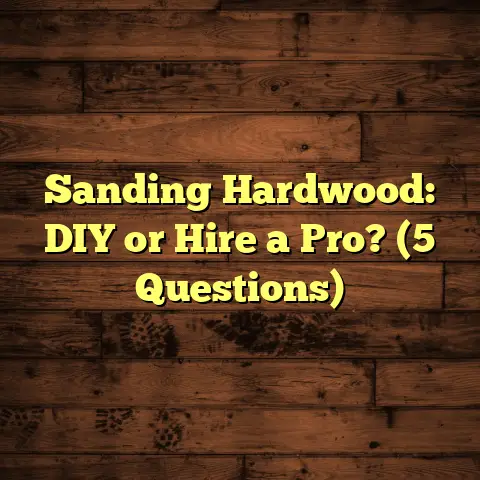Laminate Bubbles? (3 Quick DIY Fixes!)
Let’s talk about something that can really get under your skin – allergies. I’ve seen firsthand how much they can impact daily life, with symptoms like sneezing, itchy eyes, and a constant stuffy nose.
Did you know that dust mites, pet dander, and mold are some of the biggest culprits? These allergens thrive in our homes, and certain flooring types can make the problem worse if we’re not careful.
Think about it: carpets can trap allergens, and even hardwood floors can accumulate dust in the crevices. That’s where laminate flooring comes in. It’s a popular choice for many homeowners, and I get it!
It’s affordable, looks great, and is relatively easy to install. However, like any flooring material, laminate isn’t without its challenges.
One common issue I’ve encountered time and time again is bubbling. These unsightly bumps not only ruin the smooth look of your floor but can also trap allergens and contribute to poor indoor air quality.
That’s why I’m here to share some quick DIY fixes that can help you tackle those pesky laminate bubbles head-on.
Trust me, you don’t need to be a professional contractor to get your floors looking great again!
In this article, I’ll walk you through three simple methods to address laminate bubbles, empowering you to take control of your home’s maintenance and create a healthier living environment.
So, grab your toolbox, and let’s get started!
Section 1: Understanding Laminate Bubbles
Okay, let’s dive into the nitty-gritty of laminate bubbles. What exactly are they, and why do they happen?
Essentially, laminate bubbles are raised areas on your laminate flooring. They’re usually caused by moisture intrusion, poor installation, or temperature fluctuations.
Think of it this way: laminate flooring is made of several layers, including a high-density fiberboard (HDF) core.
This core is susceptible to absorbing moisture, which can cause it to swell and separate from the decorative top layer, leading to those dreaded bubbles.
Signs of Bubbling:
-
Visual Observations: The most obvious sign is seeing raised areas or bumps on your floor. These bubbles can vary in size, from small, barely noticeable bumps to larger, more prominent ones.
-
Structural Integrity: Bubbles can compromise the structural integrity of your flooring. Over time, they can weaken the laminate, making it more prone to cracking or breaking.
-
Squeaking or Creaking: You might notice a squeaking or creaking sound when you walk over the affected area. This is because the laminate is no longer properly supported.
-
Peeling or Cracking: In severe cases, the laminate surface may start to peel or crack around the bubble.
Now, let’s talk about how these bubbles can impact your indoor air quality and potentially exacerbate allergy symptoms.
As I mentioned earlier, bubbles can trap allergens like dust mites, pet dander, and mold spores. These allergens can then circulate in the air, triggering allergic reactions.
According to the EPA, indoor air can be two to five times more polluted than outdoor air. (Source: https://www.epa.gov/report-environment/indoor-air-quality)
Addressing bubbling promptly is crucial for several reasons. First and foremost, it prevents further damage to your flooring. The longer you wait, the more likely the bubble is to grow and cause more extensive damage.
Secondly, addressing bubbling helps maintain a healthy living environment. By removing the trapped allergens, you can improve your indoor air quality and reduce the risk of allergic reactions.
Finally, fixing bubbles improves the overall appearance of your floor, restoring its smooth, even surface.
Trust me, tackling these issues early on can save you a lot of headaches (and money) in the long run!
Section 2: DIY Fix #1: The Iron Method
Alright, let’s get to our first DIY fix: the iron method. This technique works best for small bubbles that haven’t been around for too long.
Here’s what you’ll need:
- A clean cloth (cotton or microfiber works best)
- An iron
- Optional: A moisture barrier (like a piece of plastic wrap)
Step-by-Step Guide:
-
Identify the Bubble: Carefully examine your floor and locate the bubble you want to fix. Note its size and shape.
-
Prepare the Cloth: Dampen the clean cloth with water. Make sure it’s not soaking wet; you just want it to be slightly damp.
-
Cover the Bubble: Place the damp cloth directly over the bubble. If you’re concerned about moisture seeping into the laminate, you can place a piece of plastic wrap between the cloth and the laminate.
-
Set the Iron: Set your iron to a low setting. Important: Make sure the steam function is turned off! You don’t want to introduce more moisture to the area.
-
Apply the Iron: Gently place the iron on top of the damp cloth. Press down lightly and move the iron around in a circular motion for a few seconds.
The heat from the iron will help to soften the laminate and allow it to re-adhere to the subfloor.
-
Cooling Time: Remove the iron and carefully lift the cloth. Allow the area to cool completely. This may take a few minutes.
-
Check the Results: Once the area is cool, check to see if the bubble has flattened. If it has, great! You’ve successfully fixed the bubble. If not, repeat the process a few more times.
Tips for Success:
-
Start Low: Always start with the lowest heat setting on your iron. You can gradually increase the heat if needed, but it’s better to be cautious and avoid damaging the laminate.
-
Don’t Overheat: Avoid leaving the iron in one spot for too long. This can cause the laminate to scorch or discolor.
-
Use a Clean Cloth: Make sure your cloth is clean and free of any dirt or debris. You don’t want to transfer any grime to your laminate floor.
-
Be Patient: It may take several attempts to completely flatten the bubble. Don’t get discouraged if it doesn’t work right away.
Potential Pitfalls to Avoid:
-
Using Too Much Heat: As I mentioned earlier, using too much heat can damage your laminate floor. Always start with a low setting and gradually increase it if needed.
-
Using Steam: Steam can introduce more moisture to the area, which can actually make the bubble worse. Make sure the steam function on your iron is turned off.
-
Applying Too Much Pressure: Pressing down too hard on the iron can also damage the laminate. Use a gentle touch and let the heat do the work.
I’ve used this method on countless occasions, and it’s often the easiest and most effective way to fix small laminate bubbles. Give it a try, and let me know how it works for you!
Section 3: DIY Fix #2: The Injection Method
Okay, let’s move on to our second DIY fix: the injection method. This technique is perfect for larger bubbles that the iron method just can’t handle.
Here’s what you’ll need:
- Wood glue or laminate adhesive (make sure it’s compatible with your laminate flooring)
- A syringe (without the needle, of course!)
- Small clamps or weights
- A clean cloth
Step-by-Step Guide:
-
Assess the Bubble: Carefully examine the bubble to determine its size and location. You’ll need to inject the adhesive underneath the laminate, so identify the best entry point.
-
Lift the Edge: Use a thin, flat tool (like a putty knife or a thin spatula) to carefully lift the edge of the bubble. Be gentle! You don’t want to tear or damage the laminate.
-
Prepare the Syringe: Fill the syringe with your chosen adhesive. Make sure there are no air bubbles in the syringe.
-
Inject the Adhesive: Insert the tip of the syringe underneath the lifted edge of the laminate. Slowly and carefully inject the adhesive into the bubble.
Try to distribute the adhesive evenly underneath the entire bubble. You don’t want to use too much, but you want to make sure the entire area is covered.
-
Press Down: Once you’ve injected the adhesive, gently press the laminate back down onto the subfloor. Use a clean cloth to wipe away any excess adhesive that may squeeze out.
-
Secure with Clamps or Weights: Place small clamps or weights on top of the repaired area to hold the laminate in place while the adhesive dries.
This will ensure that the laminate adheres properly to the subfloor.
-
Allow to Set: Allow the adhesive to set according to the manufacturer’s instructions. This may take several hours or even overnight.
Avoid walking on the repaired area during this time.
-
Remove Clamps/Weights: Once the adhesive is completely dry, remove the clamps or weights.
-
Clean Up: Clean up any remaining adhesive with a damp cloth.
Ideal Conditions for This Method:
-
Temperature: The ideal temperature for this method is between 60°F and 75°F. Extreme temperatures can affect the drying time of the adhesive.
-
Humidity: Avoid performing this repair in high humidity. High humidity can also affect the drying time of the adhesive.
Ensuring a Clean Finish:
-
Use the Right Adhesive: Make sure you’re using an adhesive that is specifically designed for laminate flooring. Using the wrong adhesive can damage your floor.
-
Don’t Use Too Much Adhesive: Using too much adhesive can cause it to squeeze out from under the laminate and create a mess.
-
Wipe Away Excess Adhesive: As I mentioned earlier, be sure to wipe away any excess adhesive with a damp cloth before it dries.
-
Use Clamps or Weights: Using clamps or weights will help to ensure that the laminate adheres properly to the subfloor and creates a smooth, even finish.
I’ve found this method to be incredibly effective for fixing larger laminate bubbles. It’s a bit more involved than the iron method, but it’s well worth the effort when you’re dealing with a stubborn bubble.
Section 4: DIY Fix #3: The Replacement Method
Alright, folks, let’s talk about the big guns: the replacement method. This is what you’ll need to do when a section of your laminate flooring is beyond repair due to severe bubbling or other damage.
Here’s what you’ll need:
- Replacement laminate planks (make sure they match your existing flooring)
- Laminate cutter or saw
- Tapping block
- Spacers
- Pry bar (optional, but helpful)
- Hammer
Step-by-Step Guide:
-
Identify the Damaged Area: Carefully examine your floor and identify the plank (or planks) that need to be replaced.
-
Select Matching Replacement Planks: This is crucial! You want to make sure the replacement planks match your existing flooring in terms of color, style, and thickness.
Take a sample of your existing flooring to the store to ensure a perfect match.
-
Remove the Damaged Plank: This can be tricky, depending on how your laminate flooring was installed.
If the plank is easily accessible, you may be able to use a pry bar to gently lift it up.
If the plank is locked into place with other planks, you may need to use a laminate cutter or saw to carefully cut around the damaged plank and remove it.
Be careful not to damage the surrounding planks!
-
Prepare the Subfloor: Once you’ve removed the damaged plank, clean the subfloor underneath. Make sure it’s clean, dry, and level.
Remove any debris or adhesive that may be present.
-
Install the New Plank: Now it’s time to install the replacement plank.
If your laminate flooring uses a click-lock system, simply align the new plank with the surrounding planks and click it into place.
Use a tapping block and hammer to gently tap the plank into place, ensuring a tight fit.
If your laminate flooring requires adhesive, apply a thin layer of adhesive to the subfloor and carefully position the new plank.
Use spacers to allow for expansion and contraction.
-
Ensure Proper Fitting: Make sure the new plank fits snugly with the surrounding planks. There shouldn’t be any gaps or unevenness.
-
Secure in Place: If you’re using adhesive, allow it to dry completely before walking on the repaired area.
If you’re using a click-lock system, make sure the plank is securely locked into place.
Matching Laminate Styles and Colors:
This is where things can get a bit challenging. Laminate flooring comes in a wide variety of styles and colors, and it’s important to find a replacement plank that matches your existing flooring as closely as possible.
Here are a few tips for finding the perfect match:
-
Take a Sample: As I mentioned earlier, take a sample of your existing flooring to the store when you’re shopping for replacement planks.
-
Check the Batch Number: Laminate flooring is often produced in batches, and the color can vary slightly from batch to batch. Check the batch number on your existing flooring and try to find a replacement plank with the same batch number.
-
Consider the Finish: Laminate flooring comes in a variety of finishes, such as smooth, textured, and embossed. Make sure the replacement plank has the same finish as your existing flooring.
-
Don’t Be Afraid to Ask for Help: If you’re having trouble finding a matching replacement plank, don’t be afraid to ask for help from a flooring professional.
I know this method seems a bit daunting, but trust me, it’s totally doable! With a little patience and the right tools, you can replace a damaged section of your laminate flooring and restore its beauty.
Conclusion
So there you have it: three quick DIY fixes for tackling those pesky laminate bubbles! I hope you found these tips helpful and informative.
Remember, addressing laminate bubbles quickly is crucial for maintaining not only the aesthetic appeal of your floor but also a healthier indoor environment, especially if you or someone in your family suffers from allergies.
By taking proactive measures to fix these issues, you can prevent further damage, improve your indoor air quality, and create a more comfortable living space.
I encourage you to assess your laminate flooring regularly for signs of bubbling and to take action as soon as you notice any problems.
These DIY fixes can save you money and time, making home maintenance accessible to everyone. Plus, there’s a certain satisfaction that comes from tackling these projects yourself.
Now, I’d love to hear from you! Have you ever dealt with laminate bubbles in your own home? What methods have you used to fix them? Do you have any additional tips or tricks to share?
Let me know in the comments below! I’m always eager to learn from my readers and share our collective knowledge.
And remember, if you’re ever unsure about how to proceed with a DIY project, don’t hesitate to consult with a professional flooring contractor.
Thanks for reading, and happy flooring!





